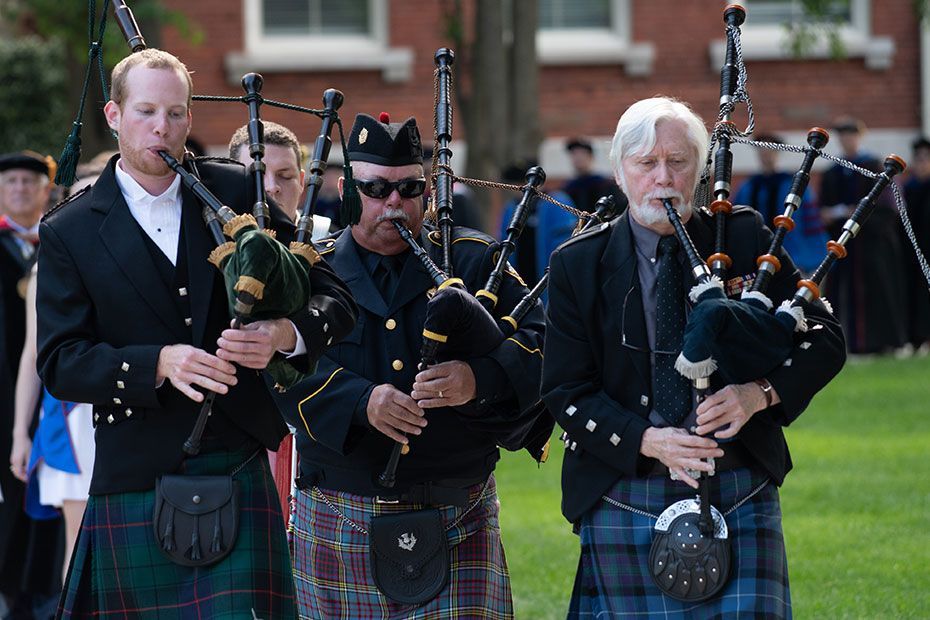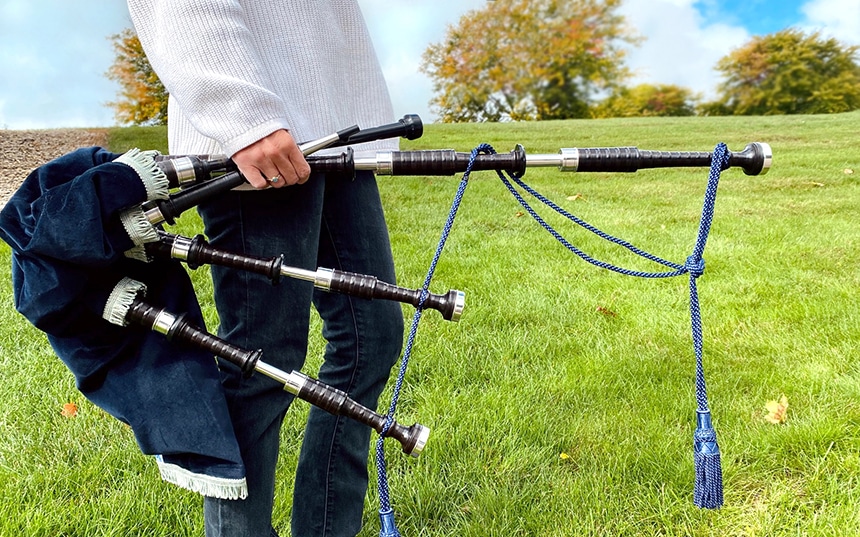There are so many types of instruments all around the world, with many of them truly unique in their shape and how they are played. Well, bagpipes Trusted Source Bagpipes - Wikipedia Bagpipes are a woodwind instrument using enclosed reeds fed from a constant reservoir of air in the form of a bag. en.wikipedia.org are some of the most unique instruments you might have come across. These instruments are part of Scottish tradition, although historians say that they weren’t invented there. Do you want to learn to play bagpipes? If so, then this article is for you.
Some of what we will consider in this article include how to play bagpipes, how hard it is, how long it would take to play, and so on.
Bagpipes are notably some of the most difficult instruments to play. They depend on air control and you must play the correct notes as you blow and squeeze. You have to keep the air flowing at the right amount. You might spend almost a year learning to play this instrument.
You will find out more information about this fascinating instrument in this article.
The first time you heard or saw the bagpipe was likely in the hands of a Scotsman or woman. It is part of Scottish tradition, but it wasn’t invented there. Historians have reported that early versions of bagpipes were played in ancient Rome and have also been found in parts of Asia like Iran.
These instruments grew in popularity over the years, and you can find different versions appearing in works of art around Europe. However, no other culture took in the bagpipe as much as the Scots. When it reached Scotland, this instrument grew in popularity, and in the first and second world wars, bagpipes could be heard played by Scottish soldiers.
As you are already reading this article, you are already thinking about playing the bagpipes. Your reason for learning might because you love their sound or perhaps you heard it in a movie, or you are just curious. No matter, the truth is that there are plenty of benefits that you will gain from learning how to play this instrument.
As we have said, and as you know, bagpipes are unique instruments. And it is so loud. Since very few people know how to play it, learning how to play bagpipes can do wonders for your confidence. Many youths remark about how it has made them feel more confident in other aspects of life. And if you are good at it, the skill can help you get ahead in life as there is a market for professional pipers.

When you learn a new instrument, you enter a new community, and bagpipes are no exception. It is an excellent way of connecting with more people from across the country and the world. There are pipe bands and events in different places, and you can have membership in any of the bands. Having friends is great, and learning how to play this instrument is one way of broadening your friendships.
If you love a challenge, then you will love bagpipes. It is one of the more complicated instruments to learn, and when you learn it, your build confidence. It is also good for your mental development since it requires plenty of coordination and eye-hand combinations. Since you have to memorize music, it serves as an excellent exercise for your brain.
Some makers are really popular and they make the best bagpipes.
The Scottish Great Highland Bagpipe from AC Kilts is one of the more popular bagpipes loved by both beginners and professionals.
As an excellent alternative, the set of bagpipes from AJW are beautiful options that come with all you need to learn how to play the instrument.
Although it can be challenging, with the right instructor and right tools, you can learn how to play this instrument. Some of the most important things that you need include the:
Later in this post, we will talk more about this requirement, but for now, we will cover the basics. The practice chanter, as the name implies, is an instrument that you practice before you move on to the main instrument. It is made from different materials, whether plastic or wood.
This practice instrument comes as a durable option that you can easily maintain. You don’t need any special handling before you can use it. Due to the material of the build, it will last for a long time. The design is in form of a bottom for fingering and a top, which is what you blow into.
Before you can successfully be a bagpipe player, there are several things that you must have in your arsenal. In this section, we will consider each of these vital factors and you will see how you can use them in becoming a better player. The factors to keep in mind include:
This first factor is arguably the most important factor that you should keep in mind when you are playing the bagpipe. Air is essential to the airbag. If you fail to supply the airbag with air, it will not play.
Older versions of bagpipes required that the player used his or her tongue to cover the top of the blowpipe during inhalation. If not done, the air would leave the pipe. You can imagine how hard it was to play the bagpipe back then. It boggles the imagination how they managed to play this instrument in the past. No wonder that pipers were viewed with such respect in their communities then.
Well, things are easier today. There is no need to cover any top with the tongue. Instead, the modern bagpipes are designed with a non-return valve. This is a useful addition that will stop any air from escaping. And it doesn’t need you to cover the tip of the blowpipe.
There are also bagpipes with bellows. These bellows are similar to those found on an accordion. The function is to supply air into the bagpipe. With this new design, the player found it easier to blow air into the bagpipe. There is no need to cover the tip of the blowpipe as well. Some ancient bagpipes have been found that come with this design. You can still find some with this design.
However, while the bellows design is cool, it is still hard to use such bagpipes. Some people prefer to blow air themselves into the blowpipe.
The two types of bagpipes can be hard to learn, but since there are two options, you can choose which of them is better for you. Let’s now move on to the next factor to consider.

Apart from the ability to blow air into the blowpipe, you also have to keep the air supply in mind. What does this mean? It means that you can supply the correct amount of air into the bagpipes consistently. If the air supply is not steady, you will not get the sound that you want.
When you blow correctly into the bagpipe, the bag stays blown for up to 25 seconds. It is during this time that you have to get the air into the parts of the bagpipe like the drones and the chanter. Apart from that, the bag must have enough pressure inside. If the pressure is off, there will be a problem with the pitch and you will even sound out of tune.
When playing the bagpipe, there are certain temptations to avoid. For example, when playing, you might want to blow the air into the bagpipe in tempo with the music. If this urge comes, kill it. If you give in, you are very likely to ruin the performance. Why? Well, if you blow air in tempo with the music, the right amount of air will not be supplied into the instrument, and this will not let you achieve the right amount of air pressure. Therefore, while you want to compliment the music, you must be focused at all times and avoid blowing along with the tempo of the music.
The same should be applied to all types of bagpipes. For example, if you are playing a model that has bellows, it must have a steady supply of air into all the important parts. To that end, your squeezing arm should be relaxed all the time.
Another thing that anyone looking to master the bagpipes must keep in mind is the way of distributing the air supply. If you don’t know how to do that, as we have outlined earlier in this post, then you will run into serious issues when you are trying to tune the bagpipe. It must be done properly for the right tuning.
A lot of instruments need to be tuned before they are played, and bagpipes are no exception. Musicians have to tune their instruments for the best performance. Well, the same goes for the bagpipes, especially those that aren’t run on bellows. If you have a mouth-blown option, then you certainly need to tune it before you start playing. Why so? Well, for one, mouth-blown models come with certain downsides in this regard. The changes that occur as the reed gets moisture and increases of temperature decreases can affect the sound that it gives. This is all instead of the sensitivity.
One of the more popular types of the reed is the chanter reed. With this type, you have to flatten the reed or even sharpen it before the right notes can be hit. There are different ways to do this. One of the tested methods through the years has been the application of wax to the finger holes for correct control of the notes.
As you learn the bagpipe, you will have to learn how to manage the chanter reed. For beginners, this is one of the most stressful aspects of learning to play. However, don’t let the frustration make you give up. Continue to practice and you will get how to manage the chanter reed in no time.
Another type of reed that is needed for tuning, depending on the bagpipe you are blowing is the drone reed. The good thing about this is that you don’t have a lot of issues with it. While there are some issues, these are usually minor.
During your learning process or through the reading of this post up to this point, you know how the bagpipe produces sound. With that in mind, it is clear that the sound stops when the instrument doesn’t have air inside. You must have air in the bagpipe if you want to play a single note, not to talk about playing similar notes consecutively.
In this situation, the bagpipe player uses something called grace notes, and it involves the fingering of the bagpipe. It is a lovely skill to master as it makes your playing seem flawless.
The main challenge in this regard is that once there is air in the bagpipe, it will continue to produce sound. This means that unlike some other instruments, there is no silence between the notes that you play. Grace notes, as we have pointed out, come in pretty handy in this regard. Apart from helping you to play similar notes consecutively, it serves other purposes.
For one, it adds character and color to the music being played. With grace notes, it is easier to manage the awkward finger positions needed to play the bagpipe.
Now that you have all these factors in mind, you can now learn to play the music from this instrument. Once again, it is an instrument that relies on air for sound. Therefore, blowing into it will cause a sound to emanate. And the sound will not stop until all the air is out. Therefore, you must have all the notes you wish to play handy. If not, you will stumble from one noisy action to the other.
As a player, you must have the presence of mind. If you don’t, you will find it pretty hard to master the instrument. As a beginner, the initial sounds from the bagpipe, which continues until there is no more air, can be distracting. That is why you need to build up a presence of mind.
Before you get comfortable with playing this instrument, you must have a lot of practice. You also have to keep at it despite the stumbling that will certainly occur. While these instruments can be difficult to learn, practicing can help you become a really good player.
As we have said, it can be a hassle learning to play the bagpipe, but if you want to learn, then you need to know about practice chanters. What are these, and why are they useful?
Well, this chanter refers to the practice instrument of the beginner. While it is most associated with beginners, they aren’t the only group of players that use it. Expert players also use these chanters, especially when they are learning a piece of new music.
After they have mastered the music, then they move on to playing on the bagpipes.
Why is the practice chanter so useful?
Well, for one, it is quieter than the actual bagpipes. You can use it if you are not looking to make noise. Additionally, it is easier to blow into the chanter than to blow into the bagpipes. It is less stressful and takes less effort. For learning new music, we recommend that you use this. So, how can you get the best one?
There are some factors to keep in mind. Let’s now consider them:
All of the factors that we have considered are important when using practice chanter. You should master the chanter first because it would make it easier for you to move to play the bagpipes.
Here’s a quick video explaining the basic scale on the practice chanter.
If you are just starting to play, here are four things that you should avoid doing whenever you are playing:
A secret to playing well is holding the bagpipe correctly. Here are the steps to take:
If you want to get the best from your bagpipe, you have to take care of it. Here are some tips from experts on how you can care for the bagpipes.
Since the pipe goes into your mouth, there are high chances that microorganisms find a home in it. Therefore, after each session, thoroughly clean the instrument. You should swab it after each performance to keep it healthy.
If you move around with your instrument, it is only right that you keep it safe. Therefore, invest in a high-quality case that will keep your instruments safe and sound throughout your movement periods.
Earlier in this post, we recommended getting a teacher if you are serious about learning how to play. Well, once again we advise that you get one. A teacher comes with plenty of advantages. When you have a teacher, you can play and have them look over your playing. If any issues need to be straightened, the teacher will point them out and assist you to make good progress.

It can be difficult to learn a new tune on the bagpipe because, as we said, you cannot start and stop the instrument. It can be hard to remember the notes to be played since the bagpipe is always producing sound.
While bagpipes are not easy to learn or master due to the complexity of piping, you certainly can learn it. If you want to learn how to play bagpipes, you have to be patient and diligent. Take your time to learn, and soon, you will be playing to the delight of your friends and yourself.
What a mishmash of information. Too much, too soon…and enough to scare a potential student. Who cares what pipers did before blowpipe valves. And wax on holes? (instead of tape, which is what most of us use). Not a good intro to the pipes. It’s an instrument of “increasing distractions”; easy to learn (on PC); hard to master. Again, not a good or welcoming intro to this instrument.